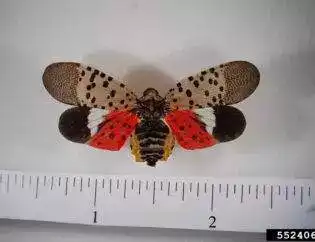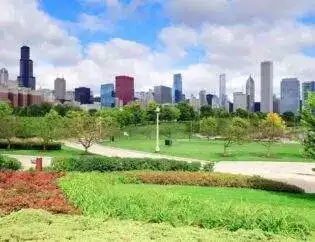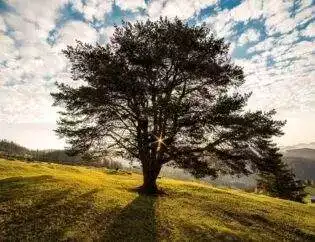
Just like humans do occasionally, trees get sick and recognizing the most common tree diseases will help you treat them and keep the benefits they offer for years to come.
Trees in the Chicago area remove around 18,000 tons of pollution, which has an estimated value of $137,000,000 annually.
It is safe to say that trees do not only help you breathe easier but they are also beneficial to Chicago residents' pockets in so many ways. Trees have also been proven to increase a residential property's value, so taking care of them is a necessity.
There are a lot of tree species in Chicago and some of them have diseases specific to their species. Some examples are maple tree diseases or oak tree diseases.
Common Chicago Area Tree Species
To better understand and treat those afflictions, we first need to look at the most common tree species in the Chicago area. According to the USDA's Forest Service, these are the most popular tree species in this area:
- European buckthorn
- Boxelder
- Green ash
- Silver maple
- Black cherry
- American elm
- Black walnut
- Sugar maple
- Northern red oak
- Bur oak

Based on this data, we can take a look at the most common tree diseases in the Chicago area.
The European buckthorn is the predominant species in the area, probably because it is an invasive species. It is usually smaller than other trees and contributes much less to the overall tree benefits, making it a problem tree.
In fact, Buckthorn competes with native species to the point that it now represents 42% of Lake County's tree population and 32% of Cook County's. This has prompted local partnerships such as the Chicago Region Tree Initiative to create programs that battle the spread of buckthorn in the region.
Around 70% of the trees in the Chicago area are on privately owned land. What this fact implies is that homeowners' help is crucial to eradicating buckthorn in the area.
How Buckthorn Impacts Other Species:
- It casts a lot of shade that prevents the growth of native species
- It drains the soil of nutrients necessary to those species
- With the help of birds, buckthorn spreads really fast. It works as a laxative for those birds. Besides spreading the seeds, the bird droppings cover a large area and stain things such as cars and outdoor furniture.
It is one of the most common non-invasive tree species in the Chicago area.
Boxelders are a type of maple trees, native to the Chicago region.
Common boxelder tree diseases:
Verticillium Wilt (Fungus)
Leaf Spots
Powdery Mildew
Heart Rot
Crown Gall
Root Rot
Herbicide Damage
Anthracnose
Boxelders are also susceptible to certain herbicides damage. They are often home to boxelder bugs and are prone to storm damage due to their weaker structure.
It grows to a height of 70 feet or more and it is used by many homeowners as a shade tree. Green ash tree rows also act as windbreakers.
Common green ash tree diseases:
Leaf Spots
Powdery Mildew
Root Rot
Emerald Ash Borer
Wood Rots
Hairy Root
Rust
Anthracnose
Nematodes
Cankers
Scale
Carpenterworm
Emerald Ash Borer
It is also called red ash, swamp ash, or water ash.
It is a highly adaptable tree that reaches heights between 50-82 feet. It has ornamental and shade uses because of its rapid growth. However, it can be easily damaged during storms because of its weaker wood.
Common Silver Maple Diseases:
Anthracnose
Verticillium Wilt
Tar Spot
Chlorosis
Root Rot
Powdery mildew
The roots of the silver maple are known to cause problems such as uneven lawns, cracked walkways or masonry. Because of its forking branches, it may require more maintenance than other trees.
The black cherry or rum cherry is a medium-sized tree that averages a height between 50-80 feet. It is also prone to storm damage, but it is more resistant to decay.
Common Black Cherry Diseases & Insects
Black Knot
Leaf Spot
Chicken In The Woods Fungus
Eastern Tent Caterpillar
Because of its attractive bark, spring blossoms, and autumn colors, the black cherry tree is used for ornamental purposes.
The American Elm is a sturdy tree that is resistant to low temperatures. It is commonly planted in residential areas, lawns, and city streets.
Common American Elm Tree Diseases:
Dutch Elm Disease
Elm Yellows
Verticillium Wilt
Elm Leaf Beetle
Elm Bark Beetles
Elm Borers
The American Elm has a very attractive shape but due to it's vulnerability to the devastating Dutch Elm Disease, hybrids are recommended to be planted instead.
It grows between 80-120 feet and can be used in areas that are prone to spring flooding because of its temporary resistance to it. It produces edible nuts and high-quality wood.
Black Walnut Tree Diseases & Insects
Canker
Walnut Caterpillar
Anthracnose
Root Rot
Leaf Spot
Trunk Rot
White Mold
Nematodes
Walnut Bunch
Black walnuts take about 150 years to mature. It starts producing nuts 10-15 years into their lifecycle.
The sugar maple or rock maple is no other than the tree that produces the beloved maple syrup. It reaches heights between 80-115 feet and can live for over 400 years.
Common Sugar Maple Diseases & Insects:
Anthracnose
Canker
Root Rot
Leaf Spot
Powdery Mildew
Tar Spot
Verticillium Wilt
Scorch
Asian Longhorned Beetle
The sugar maple tree has many uses such as for producing maple syrup, quality timber and even for producing homeopathic cough syrup.
It can reach ages between 300-500 years and heights of up to 90 feet.
It is highly valued for timber production and has many uses in construction and furniture production.
Northern Red Oak Diseases & Insects
Canker
Oak Wilt
Gypsy Moth
Root Rot
Chestnut Borer
Leaf Scorch
Anthracnose
Oak Gall
Leaf Spot
Leaf Blister
Powdery Mildew
Scale
Red oak logs can also be used for firewood. The tree itself is more tolerant of salt so it can be planted in areas that are exposed to salt.
The bur oak is a shade tree that grows to a height of 70-80 feet and deals well with pollution.
Bur Oak Diseases & Insects
Bur Oak Blight
Anthracnose
Oak Leaf Blister
Twig Canker
Oak Wilt
Leaf Scorch
Oak Decline
Root Rot
Scales
Chestnut Borer
Galls
Gypsy Moth
The Bur Oak is a White Oak species. The tree needs regular maintenance such as pruning.
What You Should Do If You Suspect Your Tree Is Sick
First, you should make sure that the disease or infestation has not advanced to the point where it threatens the structural integrity of the tree. A weak tree or branch can be very dangerous for your property and your family.
Next, you should consult a certified arborist. Our company offers free quotes to make your decision risk free. An ISA certified arborist can detect issues that may not be visible to the untrained eye. Correctly identifying the tree disease or the pest infesting it may help you save the tree as opposed to some companies' recommendation to remove the tree altogether. A good arborist considers the health and usefulness of the tree first and profits second.
What Are Some Common Tree Disease Treatments?
The treatment for common tree diseases varies based on the tree species and the affliction you want to treat.
As with anything else, the best treatment for any kind of disease is prevention.
Here is a list of some common treatments:
- spraying with fungicide
- fertilizing to promote overall health
- trimming to remove badly affected branches
- disease control methods that prevent the spread of the illness to healthy parts of the tree
- exposing the newly infected base to air (for root rot)
- spraying with insecticide
- choosing the proper time to prune a tree so open wounds do not attract insects










You must be logged in to post a comment.